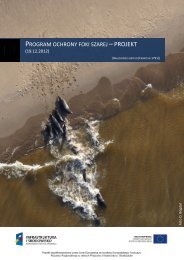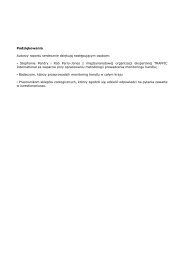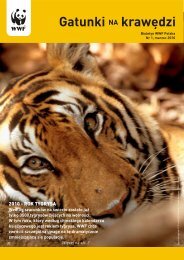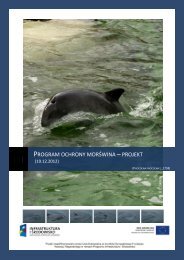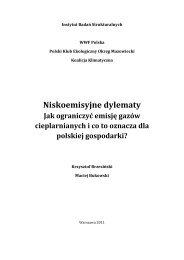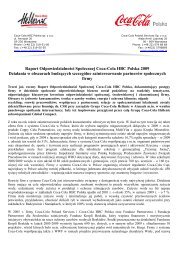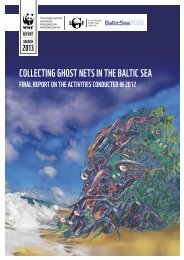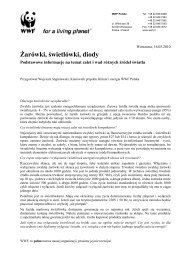Biodiversity, biocapacity and better choices
Biodiversity, biocapacity and better choices
Biodiversity, biocapacity and better choices
Create successful ePaper yourself
Turn your PDF publications into a flip-book with our unique Google optimized e-Paper software.
What does “ecological overshoot” mean?Humanity’s annual dem<strong>and</strong> on the natural world has exceededwhat the Earth can renew in a year since the 1970s. This “ecologicalovershoot” has continued to grow over the years, reaching a 50 percent deficit in 2008. This means that it takes 1.5 years for the Earthto regenerate the renewable resources that people use, <strong>and</strong> absorbthe CO2 waste they produce, in that same year.How can this be possible when there is only one Earth?Just as it is possible to withdraw money from a bank accountfaster than to wait for the interest this money generates, renewableresources can be harvested faster than they can be re-grown. Butjust like overdrawing from a bank account, eventually the resourcewill be depleted. At present, people are often able to shift theirsourcing when this happens; however at current consumptionrates, these sources will eventually run out of resources too –<strong>and</strong> some ecosystems will collapse even before the resource iscompletely gone.The consequences of excess greenhouse gases that cannotbe absorbed by vegetation are already being seen, with risinglevels of atmospheric CO2 causing increased global temperatures,climate change <strong>and</strong> ocean acidification. These impacts in turn placeadditional stresses on biodiversity <strong>and</strong> ecosystems <strong>and</strong> the veryresources on which people depend.Global hectares per capita3.532.521.510.50BIOCAPACITY =(SUPPLY)ECOLOGICAL FOOTPRINT =(DEMAND)Area x BioproductivityPopulation xConsumption xper personFootprintintensity1961 1970 1980 1990 2000 2008YearFigure 23: Trends in Ecological Footprint <strong>and</strong> <strong>biocapacity</strong> per personbetween 1961 <strong>and</strong> 2008The decline in <strong>biocapacity</strong> per capita is primarily due to an increase in globalpopulation. More people have to share the Earth’s resources. The increase in theEarth’s productivity is not enough to compensate for the dem<strong>and</strong>s of this growingpopulation (Global Footprint Network, 2011).1.5 yearsto generatethe renewableresources usedin 2008OVERSHOOTFigure 24: Factorsdriving EcologicalFootprint <strong>and</strong><strong>biocapacity</strong> (GlobalFootprint Network, 2011)Biocapacity factorsBioproductive area: The area availableof cropl<strong>and</strong>, grazing l<strong>and</strong>, fishing grounds<strong>and</strong> forests.Bioproductivity per hectare: Anarea’s productivity can vary each year <strong>and</strong>depends on factors such as ecosystemtype, management <strong>and</strong> health, agriculturalpractices <strong>and</strong> weather. Productivity canbe enhanced to achieve more <strong>biocapacity</strong>,however this often comes at the costof a larger Ecological Footprint. Forexample, energy-intensive agriculture <strong>and</strong>heavy reliance on fertilizer may increaseyields, but requires increased inputs <strong>and</strong>generates higher CO2 emissions.Biocapacity <strong>and</strong> Ecological Footprint trendsThe Ecological Footprint is driven by consumer habits <strong>and</strong> theefficiency with which goods <strong>and</strong> services can be provided. Thegrowing <strong>biocapacity</strong> deficit – defined as when a population usesmore <strong>biocapacity</strong> than can be supplied <strong>and</strong> regenerated in a year– is driven by the combination of high consumption rates that areincreasing more rapidly than improvements in efficiency (increasingpeople’s footprint); <strong>and</strong> populations growing faster than thebiosphere’s capacity (driving down <strong>biocapacity</strong> per person).Ecological Footprint driversPopulation growth: The growingnumber of consumers is a strong driverbehind the increasing global footprint.The human population is forecast to reach7.8-10.9 billion people by 2050, with amedium estimate of just over 9.3 billion(UN, 2010). Population size also affectsthe <strong>biocapacity</strong> available to each person.Consumption of goods <strong>and</strong> servicesper person: Different populationsconsume different quantities of goods<strong>and</strong> services, primarily based on theirincome level.Footprint Intensity: The efficiency withwhich natural resources are convertedinto goods <strong>and</strong> services affects the size ofthe footprint of every product consumed.This varies between countries.WWF Living Planet Report 2012 page 40 Chapter 1: The state of the planet page 41



